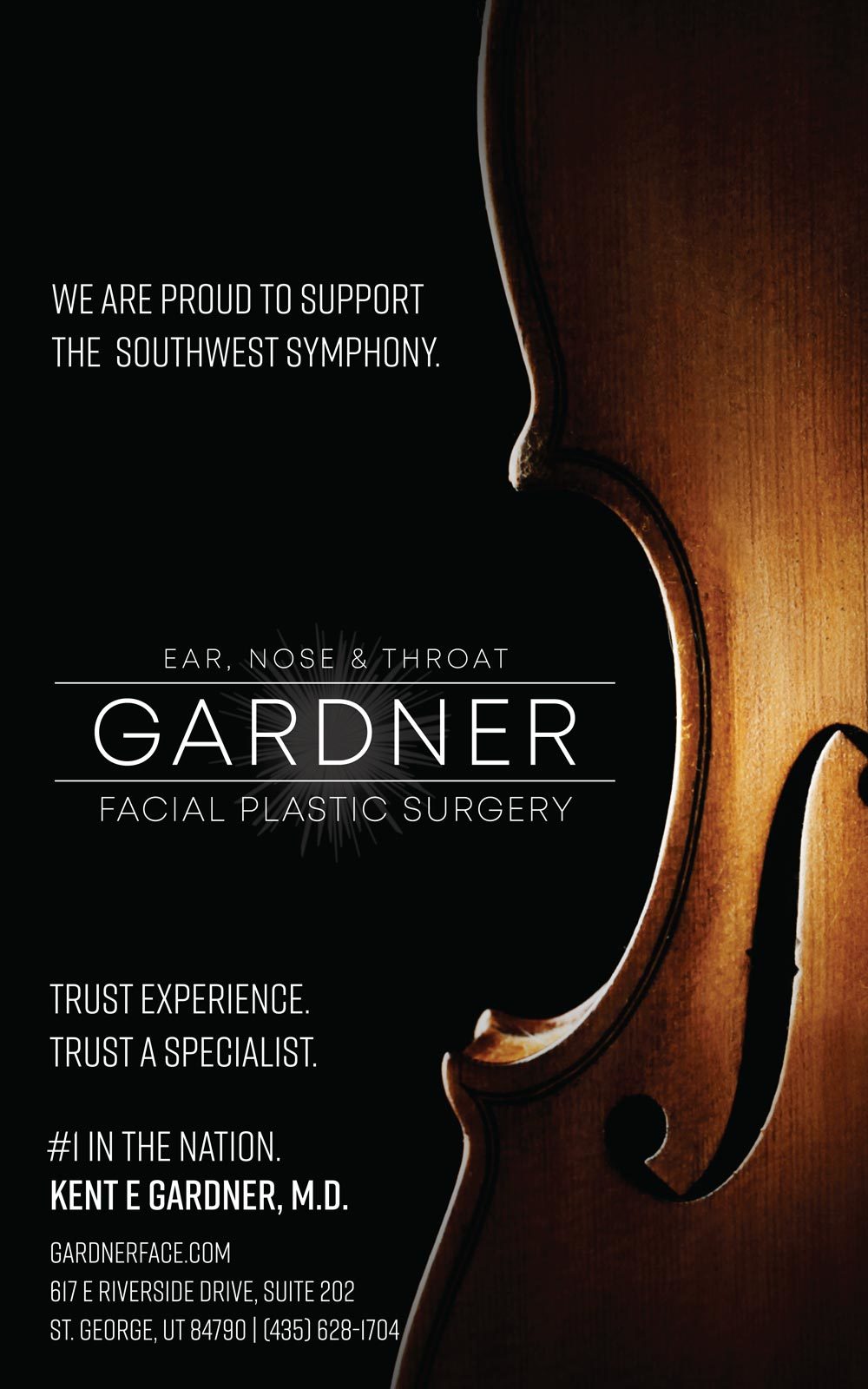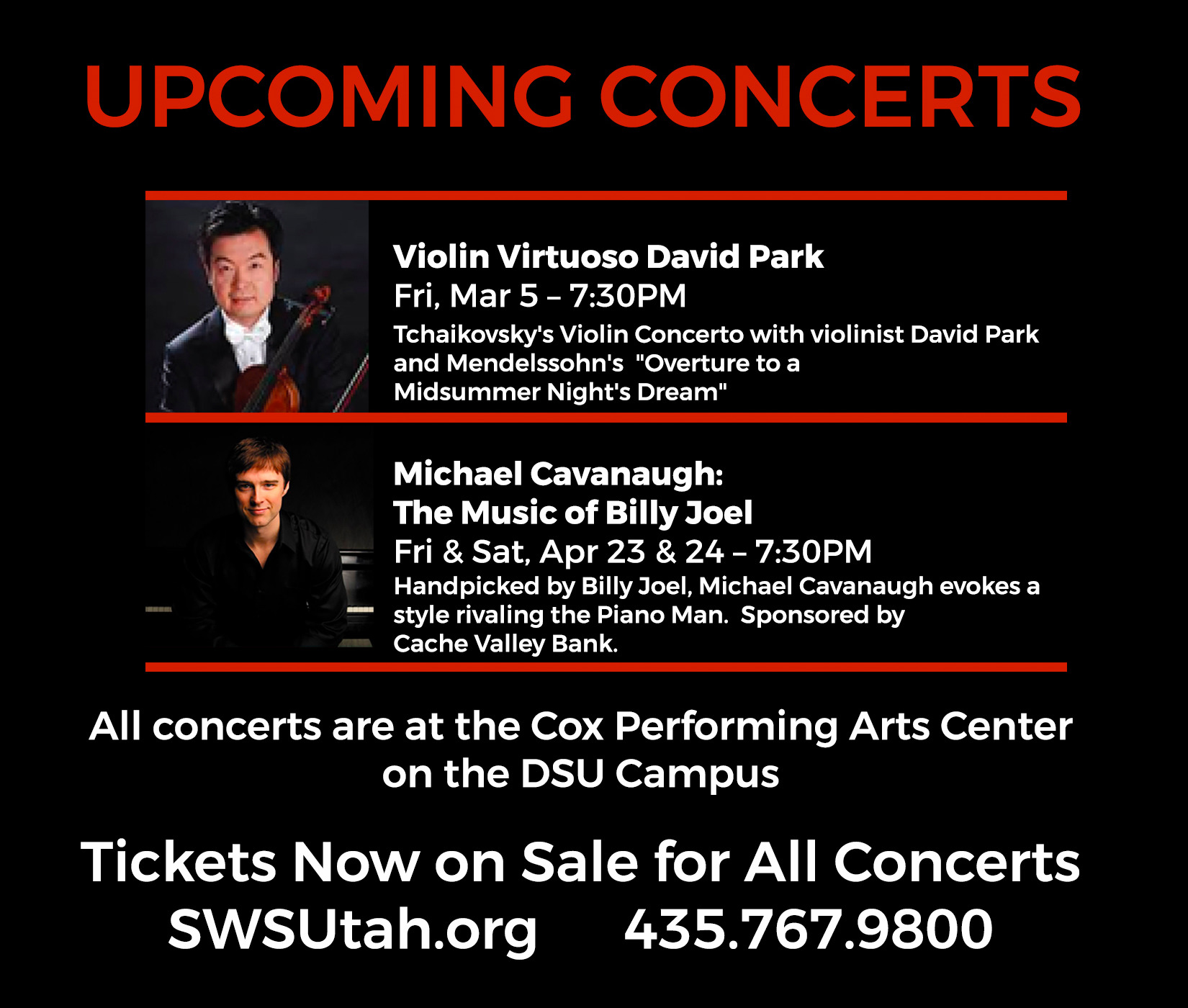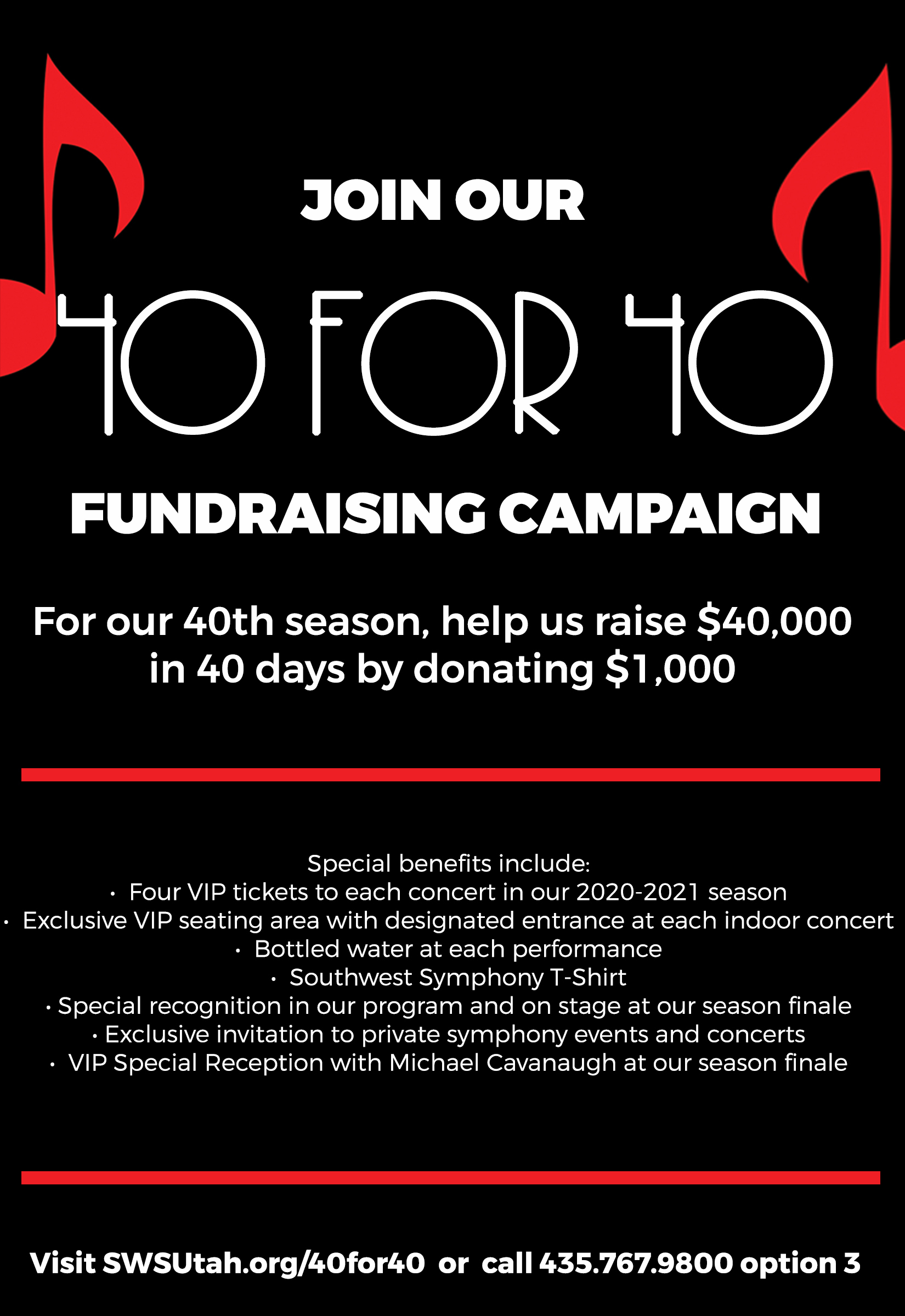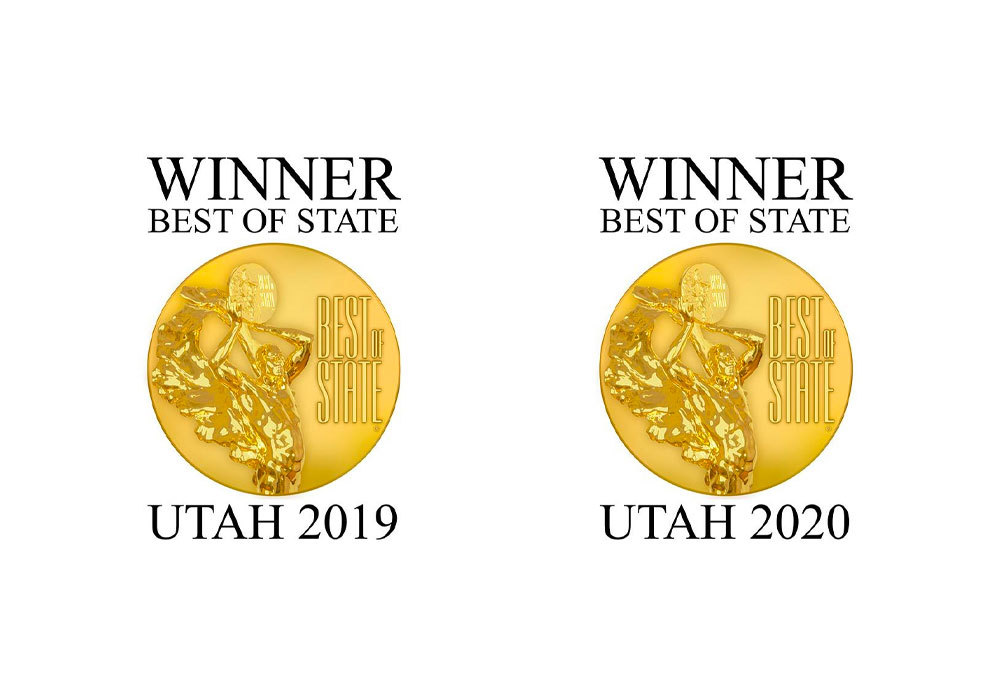Use Preferences to change the theme
Theme:
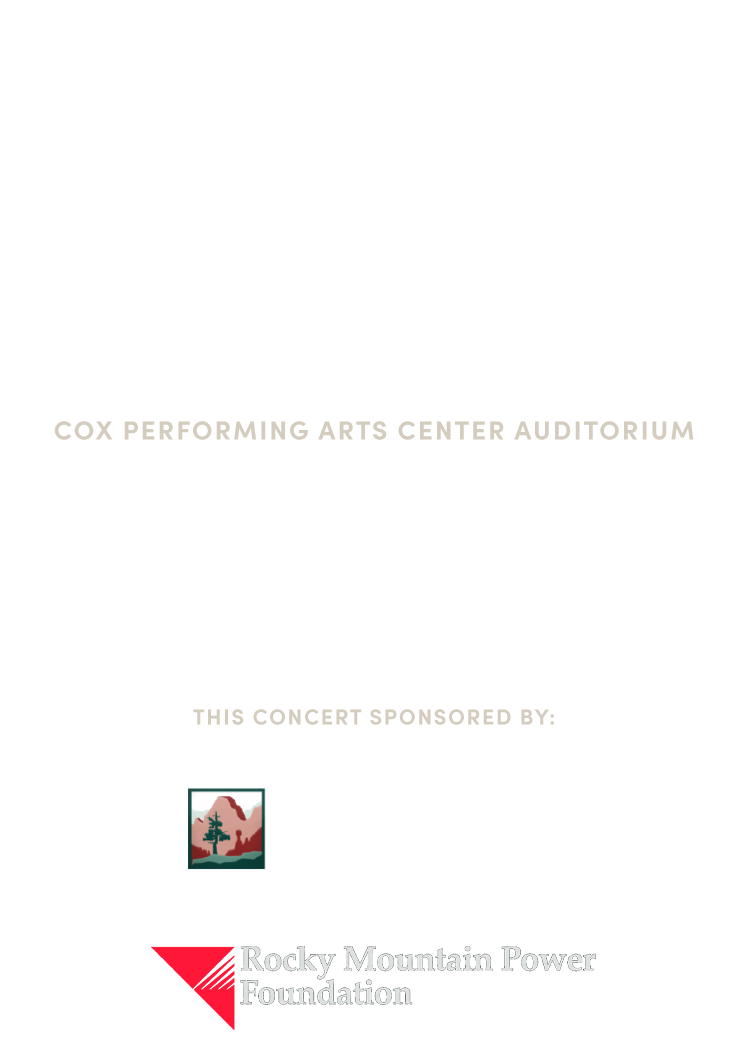
Thank you!

Follow us:
Tonight’s Program
.......
Piano Concerto No. 5 in E-flat Major, Op.73
Brandon Lee, Piano
Ludwig van Beethoven (1770-1827)
III. Rondo: Allegro
.......
Violin Concerto in D Minor, Op. 47
Competition Gold Medalist Anna Cain, Violin
Jean Sibelius (1865-1957)
I. Allegro moderato
.......
Symphony No. 7
Ludwig van Beethoven (1770-1827)
I. Poco sostenuto - Vivace
II. Allegretto
III. Presto
IV. Allegro con Brio
From the Board

Alyce Gardner
Board Chair
Dear Friends,
Happy 40th anniversary Southwest Symphony! What an amazing 4 decades it has been filled with inspiring music. I am personally honored to have been a part of the symphony for almost 10 years both as a violinist and administrator. This legendary group of dedicated music professionals has tirelessly volunteered their time, resources and energy into keeping music alive in our community. There's no doubt - there is no substitute for live music.
We now have a unique opportunity to pledge our sustaining support. I invite you to become a friend of the symphony and give whatever you can. Your donation is critical to our future now more than ever. There are many ways to give including the 40 for 40 Campaign or through the Crescendo Club. Every dollar makes a difference. All the details can be found on our website at swsutah.org.
Please don't hesitate to reach out to me if you have questions about the symphony, you would like to become a donor, or maybe you just want to chat about your favorite composer. We are here to serve our community and we deeply appreciate your support as we continue to bring YOU music that enriches and brings joy to your life.
Here’s to another great 40 years!
Meet the Maestro
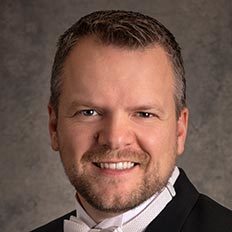
Lucas Darger
Lucas Darger returns for his fifth season with the Southwest Symphony. The Symphony has flourished under his leadership, and his innovative programming and dedication to excellence has resulted in sold-out performances becomes a regularity. Artistry has reached new heights, ticket sales have more than tripled, and the symphony has added to its educational outreach programs, giving free concerts to more than 3000 local elementary children. He has forged new ties within the community, increasing collaborations both in and out of the concert hall with local arts groups as well as other non-profits, and has established a pre-show tradition that allows students and local musicians incredible performance opportunities. He is a passionate conductor and musician and strives to achieve expressive performances that captivate and energize audiences.
Darger began his conducting career when he was just sixteen years old, and has gone on to conduct orchestras across the United States. He earned a Master’s degree in Orchestral Conducting from the University of Iowa, where he studied with the renowned Dr. William LaRue Jones, and he obtained his Bachelor’s degree in Violin Performance from the University of Utah, where he also studied conducting with Dr. Robert Baldwin. Afterwards he was accepted as a fellow at the prestigious Pierre Monteux School for Conductors in Hancock, Maine.
Proud to be a part of the St. George community, Darger serves on the board of the Music Booster Club at his children’s school, coaches football, and serves on the School Community Council. He loves the outdoors and enjoys hiking, mountain biking, skiing and boating.
Soloist Biographies
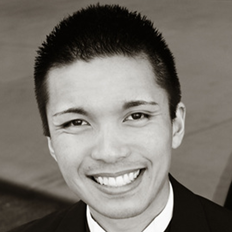
Brandon Lee
Piano
American Pianist Brandon Lee has been thrilling audiences with his technical command and tonal sensitivity in performances for almost three decades. He has worked with some of the world’s foremost pianists including Leon Fleisher, Stephen Hough, Kevin Kenner, Olga Kern, Jerome Lowenthal, Charles Rosen, as well as in chamber music settings, working with the Kalichstein- Laredo-Robinson Trio, Pacifica Quartet, and Fry Street Quartet.
He has performed in concert to critical acclaim throughout the nation, including Washington D.C., New York, California, Texas, Colorado, and throughout the greater Utah area. He is director of piano studies at Tuacahn High School for the Arts and on the piano faculty of Dixie State University.

Anna Cain
Anna Cain has been playing the violin for 11 years and currently studies with Paul Abegg. She enjoys playing in her school orchestra, duos, quartets, and the Dixie State University Orchestra. As a sophomore she was selected to play in the 2020 All-State Orchestra and is excited to be chosen this year to perform as a finalist in the Southwest Symphony Concerto Competition. Over the last four years she has participated in the Southern Utah Performing Arts Festival and received a superior rating each year.
Anna has been involved with many local orchestras, including the Zion Youth Symphony Orchestra, where she stood as concert master. She is very passionate about teaching and learning music!
Orchestra Members
Violin I
Rachel France, Concertmaster
Debbie Hafen, Assistant Concertmaster
Lacey Young
Julie Valadez
Amber Morris
Natalie Nelson
Kristen Kjar
Violin II
Joie Whittaker, Principal
Lichelle Jones, Assistant Principal
Tammy Tremea
Bette Adams
Debbie Thornton
Andrea Luikart
Melanie Nielsen
Amy Gray
Viola
Linda Ghidossi-DeLuca, Principal
Shay Manley, Assistant Principal
Cassidee Torres
Katherine Hales
Norman Fawson
Dinah Nagel
Cello
Ka-Wai Yu, Principal
Peter Romney, Assistant Principal
Jessie Coombs
Kent McDonald
Sandy Gustaveson
Mia Taylor
Leslie Jack
Debra Vradenburg
Bass
Denise Jones, Principal
Amy Gardner
Edwin Candland
Flute
Katrina Jones, Principal
Shauna Zitting
Oboe
Rhonda Rhodes, Principal
Kendyl Johnson
Clarinet
Melissa Bennion, Principal
Greg Johnston
Bassoon
Shanan Arslanian, Principal
Carolyn Johnston
Horn
David Lintz
David Hay
Tabitha Nygaard
Randy Bassuener
Trumpet
LuWayne Barber
Samuel Dickson
Trombone
Jay Nygaard
Timothy Francis
Timpani
David Salisbury
Conductor
Lucas Darger
Music Librarian
Julia Monson
Program Notes
Piano Concerto No. 5 in Eb Major, Op. 73 (“The Emperor”)
Ludwig van Beethoven, 1770-1827
Last month was the 250th anniversary of Ludwig van Beethoven’s birth in December 1770. Straddling an immense cultural, economic, and political transition in the western world, Beethoven had a revolutionary impact on shaping and changing the direction of orchestral music.
Beethoven was raised in the tightly controlled environment of late 18th-Century Europe. At this time, the entire upper class was very concerned with predictable hierarchal and social norms—another word we could use here is “order”. This is reflected in Classical-era music with its organized and predictable forms and genres. Mozart’s brilliance and Hayden’s mastery of form allowed them to push the envelope of innovation, but they were never able to stray far.
A successful democratic experiment in the nascent United States (1787) and the democratic nightmare in France (1789) both contributed to the passing of Old Order. Beethoven was not only ready for this change, but drove this shift in music as the early Romantic period emerges.
While Beethoven was dramatically influenced by his Classical training (Hayden was one of his teachers), he was not constrained by it. His genius would ultimately make the changes that lead to the Romantic (here, this means emotional, not just “love”) period and its dominance of style into the early 20th century.
Beethoven was a gifted piano player known for his ability to improvise and this propelled him to importance early. After success in mastering the old classical forms, a new, intense, and bold Beethoven emerges from 1804 to 1814. Both of tonight’s featured Beethoven works were written in this period. This was also the period that, while aware he was going deaf, Beethoven still retained a portion of his hearing.
Beethoven took orchestral music from 18th century salons of the elite to great concert halls of the people in the 19th Century. In his sounds, he becomes immortal. We are richer for having experienced his genius.
Tonight we perform the third movement of his iconic “Emperor Concerto”. The movement is structured as a “rondo”, a classical form from Beethoven’s youth in which the composer introduces a theme statement that returns several times throughout the piece. It will be hard to not leave humming this theme in our heads as we come back to it again and again, while alternating with completely new material that is developed as we progress. Almost like clockwork, the original theme will reappear regularly to unify the entire movement.
A wonderful mix of heroic and lyrical materials lead to a grand climax to create a finale that echoes in the mind long after the original sounds have faded.
Violin Concerto in D Minor, Op. 47
Jean Sibelius, 1865-1957
Born in Finland in 1865, Jean Sibelius’ long life straddled the chaotic transition between the late Romantic music traditions and the explorations of the early 20th Century. When asked, Sibelius said he most admired Arnold Schoenberg of the new composers. But like his contemporary, Serge Rachmaninoff, Sibelius kept one foot firmly planted in the Romantic tradition. Additionally, Sibelius was identified with the Finnish Nationalist movement. Composers incorporated themes, tonalities and rhythms that were the product of the folk traditions from their countries. By shaping music for the international concert halls with the accent of their native countries, composers were able to share their cultural music traditions with the entire world. This national identity became especially important as the new and aggressive USSR tried to absorb Finland, culminating the vicious Winter War of 1939. To this day, Sibelius is a Finnish cultural hero with his music performed regularly in concert halls throughout the country.
Sibelius composed his Violin Concerto nearly 100 years after Beethoven’s “Emperor” Concerto. Even with the amazing soloist doing great things on piano, the Beethoven concerto is still a unified piece in its use of structure, key progression, and thematic treatment. By the middle of the 19th Century, Mendelssohn and Schumann were trying a new approach to instrumental concertos. In the Sibelius, the soloist is superior to the orchestra, with extended exploratory sections and more involved cadenzas, which are written by the composer rather than left to the soloist to improvise as they would have been in Beethoven’s time. These concertos were an alternative to the more structured works audiences were used to. This new approach placed the focus on the virtuosity of the soloist. Sibelius used this approach for his only violin concerto—one that many scholars see as the finest example of this alternative approach to the concerto style. Originally premiered in 1903, a revised edition was introduced in 1905 with the great Richard Strauss conducting.
The opening is reminiscent of folk tonalities with the orchestra and soloist appearing to cooperate in creating a structured melody. Quickly this mood moves to periods of more intensity with an improvisational feel. This opening exploration never evolves into a recognizable, singable melody. The ideas, colors and moods move and change, one evolving from the next, taking new directions as we listen.
After several minutes of beautiful and varied exploration, underneath an extended violin trill, a defined and brisk melody is introduced by the orchestra: The allegro (fast) theme begins.
The orchestra carries this new melody and mood forward. Then slowly and quietly recedes, and the violin begins a major cadenza section. In a traditional concerto, this is the “development” portion, where the soloist explores and creates variations on the opening theme. In the Sibelius Concerto, the soloist is turned free. The entire section is a violin feature and has a spontaneous feel. This amazing section ends as the orchestra eases back in, leading to their own statement of a dramatic theme.
The movement then concludes with a beautiful violin solo that leads to a final statement of the allegro theme.
Symphony No. 7 in A Major, Op. 92
Ludwig van Beethoven, 1770-1827
This is another work from Beethoven’s middle, or “heroic” period. The actual event that prompted the premier was a benefit concert in Vienna for the wounded veterans from the seemingly continuous wars against Napoleon. Beethoven was an early supporter of Bonaparte, but soured when Napoleon went from People’s Reformer to Emperor and Conqueror. When Napoleon crowned himself emperor, Beethoven angrily scribbled out his dedication of his 3rd Symphony to the Corsican dictator.
Beethoven himself conducted the premier of his 7th Symphony and was very pleased with its reception. In fact, the audience immediately demanded that the second movement, Allegretto, be repeated as an encore.
Since this was a benefit concert, many of the foremost musicians from the City of Music participated. Included in the orchestra was world-famous composer and violinist, Louis Spohr, famous opera composer Antonio Salieri, and many others. The Italian guitar virtuoso Mauro Giuliani even played cello at the premiere.
Describing Beethoven’s conducting at the event, Spohr said that "as a sforzando occurred, he tore his arms with a great vehemence asunder ... at the entrance of a forte he jumped in the air.” As dramatic in real life as his music, Beethoven was the very embodiment of the early Romantic Era.
The first movement’s opening chords are reminiscent of the heroic style, but the mood quickly changes. Delicate ascending scales in the strings take us into a lyrical melody in the double reeds of pastorale simplicity. But, with Beethoven, the mood always changes, heroism returns, alternating with the return of the pastoral theme in different combinations of woodwinds
This development, in turn, evolves into a new melody and mood, almost dance-like in its joyfulness in the woodwinds. We are moved into a dramatic statement of the same dance tune in the full orchestra. The melody undergoes almost seamless evolution with the alternation between bold and lyrical. The movement concludes as we return to the opening themes and ends with a bold final statement in the full orchestra.
The second movement begins with an opening chord and a theme introduced in the strings, quietly and simply stated. This theme is then restated, passed around to various sections. Each rendition of varied instrumentation begins to add elements. Initially a wonderful, totally independent counter melody, is added in the low strings. Complimentary lines are introduced, sometimes becoming the main line themselves.
With moments of drama, the bulk of the movement is a clear, but complex interplay between all of the various thematic elements as they weave in and out. Unity is achieved as the movement ends with a return to the simplicity and instrumentation of the opening moments.
In direct contrast to the complex interplay of the previous movement, the presto puts you into the middle of a great country dance…Germanic country dance, that is. The energy is contagious as Beethoven takes us on whirling dance through contrasting instrumentation and variations of the theme.
But it is Beethoven, so expect surprises. With sudden abruptness, the dance character changes as a more sedate, slow dance theme is introduced in the woodwinds. The new theme is then taken up by the entire orchestra and begins to alternate with the woodwind ensemble. With sudden abruptness, we are back at the original dance, with all of its energy and orchestral color One more visit with our sedate, slow dance theme, and then we take a last energetic spin around the room to the finale.
The last movement only amplifies the energy of the third movement. The dance here is almost frantic, with heroic elements throughout. At times, the dance comes to abrupt halt, as if were Beethoven giving us a chance to rest and catch our breath. However, we know that our frantic dance is just waiting to start again. And we are never disappointed! We whirl and whirl, and then with one last development and statement of the opening theme, and we leave the floor both exhausted and overjoyed.


